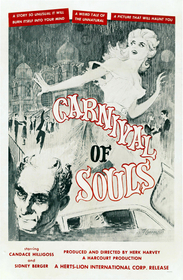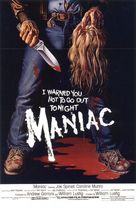Our editor-in-chief Nate Yapp is proud to have contributed to the new book Hidden Horror: A Celebration of 101 Underrated and Overlooked Fright Flicks, edited by Aaron Christensen. Another contributors include Anthony Timpone, B.J. Colangelo, Dave Alexander, Classic-Horror.com's own Robert C. Ring and John W. Bowen. Pick up a copy today from Amazon.com!
Carnival of Souls (1962)
Carnival of Souls is unlike any other movie I’ve ever seen. I don’t think it would make any serious film fan’s "best ever" list, but it is unique and at times chilling enough to have carved a niche for itself in horror history. At times this 1962 black and white indie thriller is amateurish, even downright cheesy. I must say, however, that there is a certain quality this film possesses, as do many independent and novice films, that frees it from the traditional trappings of Hollywood and allows for some genuinely fresh and inspired moments. Those inspired moments in Carnival of Souls, blended with the crudeness of the production, are amongst the most inventive and absolutely creepy in all of horror cinema.
The film lurches into the action right away. No establishing shot, no wide angled exterior view. No, what we first see is a tight shot of some young ladies in a car flirting with some young men in a car. Being the youthful hipsters of 1962 that they are, the kids propose a friendly drag race and the two cars take off out of the small town, speeding down the dirt roads of the countryside. The girl doing the driving is smoking, and while that’s a small detail we all know that is a big horror cinema no-no and will only lead to woe. Woe, in fact, is exactly what the girls find as the drag race takes them onto a bridge where the smoking girl loses control of the car and careens into the murky depths of the river below.
It is then that the star of our film takes center stage. Emerging from the river, oddly unwet but covered in muck and mud is Mary Henry (Candace Hilligoss). The only one of the girls to survive, Mary is distraught and distant, but that’s only reasonable given the recent events of her life, right? Maybe. Mary is antisocial, wanting as little to do with anyone and everyone as possible. She purposefully avoids seeing her parents even after her harrowing ordeal. Mary, a gifted pipe organist, leaves town to take a job with a church in Utah. The only thing it seems that Mary is interested in at all anymore is a large isolated pavilion she passes on the salt flats outside the town she’s moved to. The pavilion once housed a salt-water bath resort and then a carnival, but has since become dilapidated and condemned, a virtually dead place ignored by the living.
Candace Hilligoss portrays Mary as a young woman with nerves so jangled all the Paxil in the world couldn’t mellow her out. She does a nice job with the role, generally not going too far over the top, which would be easy to do with some of this dialogue. Her panic and fear seem genuine, especially as the film progresses. At one point it is said to Mary, “You have a strong will,” to which she replies, “I survive.” She does in deed survive upon will, but that will is fractured and held together most tenuously.
The main factor in Mary’s cracked psyche is the constant reappearance of a pasty-faced ghoulish looking man (played by the triple duty director-producer-actor Herk Harvey). Unseen by anyone but Mary, the silent stranger is at once both beckoning and menacing. Eventually “The Man” is joined by others like him in pursuit of Mary. It is unclear what these beings are, but they want Mary. The scenes in which they pursue her are unsettling, frightening and in your face. Watching those scenes in particular, it is easy to see how Carnival of Souls inspired George A. Romero to make Night of the Living Dead.
It doesn’t take a rocket scientist to figure out what is really going on in Carnival of Souls; I did it in about five minutes. Despite the thinness of the plot however, this is one creepy freakin’ movie! Aside from a subplot which involves Mary’s lecherous neighbor which wastes about fifteen minutes in the middle of the film, an off balance perspective and atmosphere of dread keep the film pretty tightly wound. Time is seemingly out of sync and hard to pin down throughout. Whether that’s purposeful or an accident of indie film making, it works.
The organ music which features so prominently in the life of Mary, provides the eerie, funeral/carnival fused soundtrack. The music, by composer Gene Moore, is sometimes cheesy and cheap, but it provides a very odd, unusual backdrop that elevates the tension and mood of the scenes quite effectively. After some digestion of the film, it dawned on me the music reminded me of the "Dark Shadows" theme music. "Dark Shadows," by the way was much later in the sixties, so Moore didn’t rip anything off. It’s a great sound though, like a calliope of the living dead. Spooky, spooky, spooky!
Herk Harvey made this odd little gem for an insanely low budget of $30,000. Compare that to the hundred thousand dollar budgets of some of Universal B movies of the forties and you see how cheap that really is. Filmed near the town of Lawrence, Kansas, the setting is part of what makes this movie work. If it had not been for the real-life abandoned pavilion itself, there would have been no movie. Far from the fat coffers and soundstages of Tinseltown, Harvey was allowed (or hampered into, however you look at it) to make a really unique film. Now whether it was a budgetary or vanity consideration that caused him to appear in such a large role is unknown. I can tell you however, that Harvey’s pasty-faced, wicked grin is one of the most unsettling and eerie images of the entire film.
Carnival of Souls isn’t the easiest movie to watch. It slows down a little too much in the middle and because it’s not like the easily digestible films from Hollywood, it takes some investment of attention and patience. For horror buffs and anyone wanting something different, that investment does pay off. The unfortunate fact is Herk Harvey never made another feature after Carnival. It would have been interesting to see if Harvey could have polished some of his technique and made more films as good or better than Carnival. But honestly, I think the unpolished, jagged and interestingly rough edges of Carvival of Souls are what make this forty-year old “creepy-cheapie” fresher than nearly anything to be spat out of Hollywood today.
Trivia:
Whoops! Hilligoss's finger movements on the organ don't match the music she's supposedly playing.








